|
Family:
Proteaceae (protea family) Life
> eukaryotes >
Archaeoplastida >
Chloroplastida
>
Charophyta > Streptophytina > Plantae (land plants)
> Tracheophyta (vascular plants) > Euphyllophyta > Lignophyta (woody plants)
> Spermatophyta (seed plants) > Angiospermae (flowering
plants) > Eudicotyledons > Order: Proteales
Worldwide there are about 80 genera and 1600 species. The
highest diversity is in Australia (800+ species), followed by Africa (c 400
species) and then South America (about 90 species). Proteaceae are also native
to Madagascar, SE Asia, New Guinea, New Calidonia and New Zealand. A total of 14
genera and 361 species are native to southern Africa, mainly in fynbos. In
addition, two genera and six species have become naturalised, and an additional
13 genera and 49 species are cultivated in the region.
Genera native to southern Africa
List from Rourke (2000).
|
Aulax (featherbushes)
There are three species, all found in the Western Cape, South Africa.
|
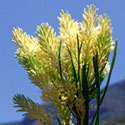
|
Brabejum (Wild
almond) The only species is the Wild Almond Brabejum stellatifolium which
is found in the Western Cape. |
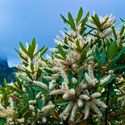 |
|
Diastella
(southern silkypuffs) There are seven species, all endemic to the Western Cape.
|
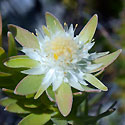
|
Faurea (beechwoods) About
15 species, found in Africa and Madagascar. There are seven species native to southern Africa.
|
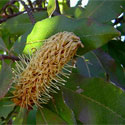 |
|
Leucadendron (conebushes)
There
are 84 species, found mainly in the Western Cape and Eastern Cape but extending as far north as KwaZulu-Natal, South Africa.
|
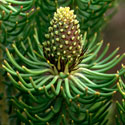 |
|
Leucospermum
(pincushions)
The 48 species are indigenous mainly to the Western Cape but the genus is also
found in Eastern Cape, KwaZulu-Natal and Zimbabwe.
|
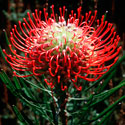
|
|
Mimetes (pagodas)
The 13 species are endemic to the Western Cape.
|
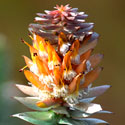 |
Orothamnus (Marsh
rose) The only species is
Orothamnus zeyheri (Marsh rose) found in the
Western Cape in the mountains above Betty's Bay and Hermanus.
|
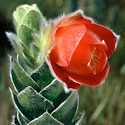 |
Paranomus (sceptres)
The 18
species are endemic to the Western and Eastern Cape.
|
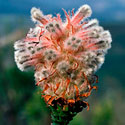 |
|
Protea (sugarbushes)
About
112 species, found in Africa but mainly in South Africa where there have been
about 89 species recorded.
|
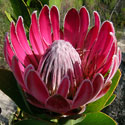
|
|
Serruria (spiderheads)
There are about 55 species, all found in the Western Cape.
|
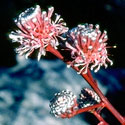 |
Sorocephalus (clusterheads) The
11 species are all found in the Western Cape.
|
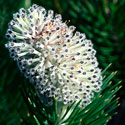 |
Spatalla (spoons)
The 20
species are all found in the Western Cape.
|
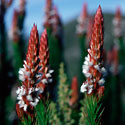 |
Vexatorella (vexators) The
four species are found in the Western Cape and southern part of the Northern
Cape.
|
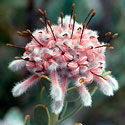 |
Genera naturalised in southern Africa
List from Rourke (2000). Species names are provided for
genera that have only one species recorded from southern Africa.
|
Grevillea (Silky oak genus)
About 260 species worldwide, native to Australia, New
Guinea, New Caledonia and Indonesia. G. banksii is commonly found in
South African towns and cities and has also become
naturalised, mainly in KwaZulu-Natal. Another 16 species are cultivated in
southern Africa, but not naturalised.
|
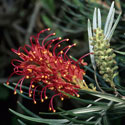 |
|
Hakea (needlebushes)
About
110 species, all native to Australia. At least five species have become
naturalised in the Western Cape and KwaZulu-Natal, and are considered weeds. An
additional six species are cultivated but not naturalised.
|
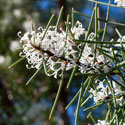
|
Other genera, cultivated in southern Africa
List from Glen (2002).
Isopogon
Two species cultivated - Isopogon anethifolius (Narrowleaf
drumsticks) and Isopogon formosus, both native to Australia. |
|
Petrophile pulchella (Conesticks)
Native to Western Australia. |
|
Conospermum triplinervium
Native to Western Australia. |
|
Buckinghamia celsissima (Ivory curl flower)
Native to northeastern Australia. |
|
Lambertia formosa (Mountain devil)
Native to eastern Australia. |
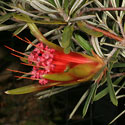 |
Macadamia (Macadamia
nut genus)
Ten species, native to subtropical eastern Australia, Indonesia and New
Caledonia. Macadamia nuts come from Macadamia integrifolia (Smooth
macadamia nut) and Macadamia tetraphylla (Rough macadamia nut).
Besides the two nut-producing species, Macadamia ternifolia is also
cultivated in southern Africa. |
|
Embothrium coccineum (Chilean fire tree)
Native to Chile and Argentina. |
|
Alloxylon pinnatum (Fern-leaved tree waratah)
Native to eastern Australia. |
|
Telopea
Telopea oreades (Gippsland waratah, Victorian waratah) and
Telopea
speciosissima (Waratah, Common waratah), both native to Australia,
are cultivated. |
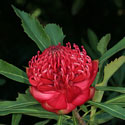 |
Knightia excelsa (New Zealand honeysuckle tree)
Native to New Zealand. |
|
Stenocarpus
Stenocarpus salignus (Scrub beefwood, Red silky oak) and
Stenocarpus sinuatus (Firewheel tree), native to eastern Australia),
are cultivated. |
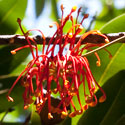 |
Banksia
Ten species cultivated. |
|
Dryandra formosa
Native to Western Australia. |
|
References
-
Coetzee JH, Rust DJ, Latsky LM. 1986. Mites (Acari)
on proteas. Acta Horticulturae (ISHS) 185: 247-252.
-
Knox-Davies PS, van Wyk PS, Marasas WFO. 1986. Diseases of
proteas and their control in the South-Western Cape. Acta Horticulturae
(ISHS) 185: 189-200.
-
von Broembsen SL, Brits GJ. Control of Phytophthora
root rot of proteas in South Africa. Acta Horticulturae (ISHS) 185: 201-207.
-
Rebelo, T. 1995. Sasol Proteas. A Field Guide to the
Proteas of Southern Africa. Fernwood Press, Vlaeberg, Cape Town.
-
Rourke, J.P. 2000. Proteaceae. In: Seed Plants
of Southern Africa: Families and Genera (Ed. O.A. Leistner). Strelitzia
10. National Botanical Institute, Pretoria, pp. 457-461.
-
Glen, H.F. 2002. Cultivated Plants of
Southern Africa. Jacana, Johannesburg.
Text by Hamish Robertson |
